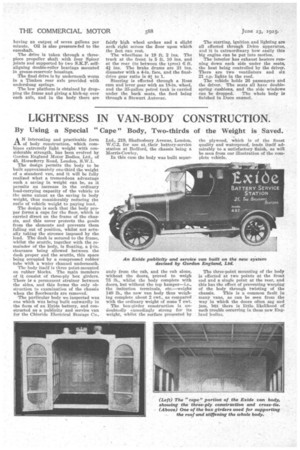LIGHTNESS IN VAN-BODY CONSTRUCTION.
Page 20

If you've noticed an error in this article please click here to report it so we can fix it.
By Using a Special "Cape" Body, Two-thirds of the Weight is Saved.
AN interesting and practicable form of body construction, which combines extremely light weight with considerable strength, has been evolved by Gordon England Motor Bodies, Ltd., of 45, Horseferry Road, London, 5.W.1.
The design permits the body to be built approximately one-third the weight of a standard van, and it will be fully realized what a tremendous advantage such a saving in weight can be, as it permits an increase in the ordinary load-carrying capacity of the vehicle to the same extent as the saving in body weight, thus considerably reducing the ratio of vehicle weight to paying load.
The design is such that the body proper forms a cape for the floor, which is carried direct on the frame of the chassis, and this cover protects the goods from the elements and prevents them falling out of position, whilst not actually taking the stresses imposed by the load. The dash is secured to the frame, whilst the scuttle, together with the remainder of the body, is floating, a fin. clearance being allowed between the dash proper and the scuttle, this space being occupied by a compressed rubber tube with a water channel underneath.
The body itself is three point-mounted on rubber blocks. The main members of it consist of three-ply box girders. There is a permanent strainer between the sides, and this forms the only obstruction to examination of the chassis when the floorboards are removed.
The particular body we inspected was one which was being built outwardly in the form of an Exide battery, and constructed as a publicity and service van for the Chloride Electrical Storage Co., Ltd., 219, Shaftesbury Avenue, London, W.C.2, for use at their battery-service station at Bedford, the chassis being a Morris-Cowley.
In this case the body was built separ
ately from the cab, and the cab alone, without the doors, proved to weigh 75 lb., whilst the body complete with doors, but without the top hamper—i.e., the imitation terminals, etc.—weighs 149 lb., the new van body thus weighing complete about 2 cwt., as compared with the ordinary weight of some 7 ewt.
The box-girder construction is undoubtedly exceedingly strong for its weight, whilst the surface presented by the plywood, which is of the finest quality and waterproof, lends itself admirably to a satisfactory finish, as will be seen from our illustration of the complete vehicle.
The three-point mounting of the body' is effected at two points at the front end and a single point at the rear, and this has the effect of preventing warping of the body through twisting of the chassis. This is a common fault in many vans, as can be seen from the way in which the doors often sag and jam, liTit there ia little, likelihood of such trouble occurring in these new England bodies.






























